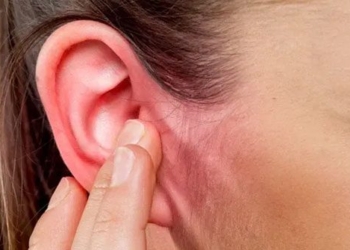Cellulitis is a common and serious bacterial infection. It is important for individuals to understand the symptoms, causes, and preventive measures of cellulitis to protect their health and recognize the condition early for appropriate treatment.
Key Information About Cellulitis
1. What is cellulitis?
Cellulitis is a bacterial infection that affects the skin and the tissues underneath it. The condition often impacts the lower parts of the body, including the legs, feet, and toes. However, it can occur in any part of the body, such as the face, arms, hands, and fingers.
Cellulitis is quite common, with over 14 million cases reported in the United States each year. If left untreated, cellulitis can spread and lead to sepsis, a life-threatening emergency.
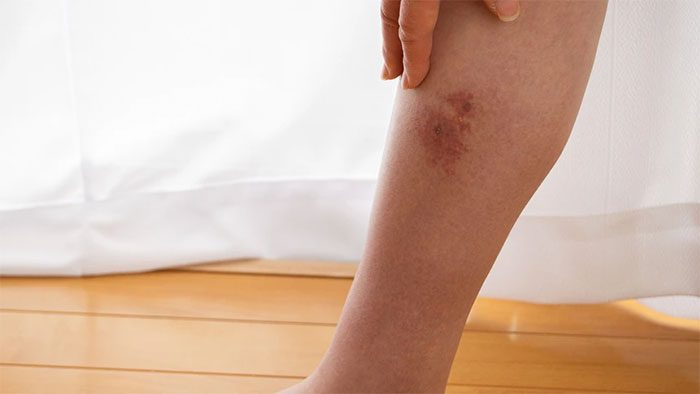
Cellulitis is a bacterial infection that affects the skin and the tissues underneath it. (Image: Internet).
2. Symptoms of cellulitis
Recognizing the signs and symptoms of cellulitis is crucial for early detection and timely medical intervention.
One typical sign of cellulitis is a change in the color of the skin around the affected area, which may range from red or pink in light-skinned individuals to purple, gray, or dark brown in those with darker skin. The affected area may also feel warmer than the surrounding skin as the body’s immune system reacts to the infection.
Swelling is one of the common symptoms of cellulitis. The inflammatory response caused by the infection can lead to swelling in the affected area, which can range from a small patch to a larger limb. Severe swelling may cause the skin to become shiny and indented.
As cellulitis progresses, changes in the skin may occur. Blisters may form, and the skin in the affected area may become thickened and pitted. Pain in the affected skin is also a common symptom. It is important to note that if pain suddenly increases or if there is tingling or numbness, immediate medical attention is necessary, as this could be a sign of compartment syndrome, a serious complication.
Cellulitis can also cause systemic symptoms throughout the body, similar to those experienced with other infections. These symptoms may include feelings of malaise, fatigue, shivering, chills, fever, and swollen lymph nodes.
If the infection spreads to the bloodstream, there is a risk of developing sepsis. Symptoms of sepsis include weak pulse, rapid heartbeat, pain, clammy skin, sweating, difficulty breathing, and confusion. Sepsis is a severe and life-threatening condition that requires immediate emergency medical care.
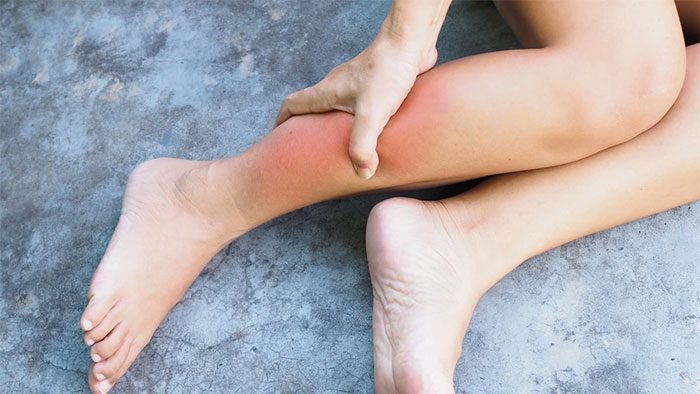
Swelling and color changes in the skin are typical symptoms of cellulitis. (Image: Internet).
3. Causes of cellulitis
The causes of cellulitis are attributed to various types of bacteria, with Group A Streptococcus being the most common.
The method by which bacteria enter the body to cause cellulitis is often unclear, but it can occur through open wounds on the skin. However, cellulitis is not contagious and cannot be transmitted from one person to another.
4. What are the risk factors for cellulitis?
Several factors increase the risk of developing cellulitis, including:
– You are more likely to develop cellulitis if you have skin conditions such as eczema or athlete’s foot. Bacteria can enter your skin through cracks caused by these conditions.
– A weakened immune system also increases the risk of developing cellulitis as it cannot provide adequate protection against infections.
– Other risk factors include:
- Cuts, scrapes, or other wounds on the skin
- Diabetes
- Swelling in your arms or legs (lymphedema)
- Obesity
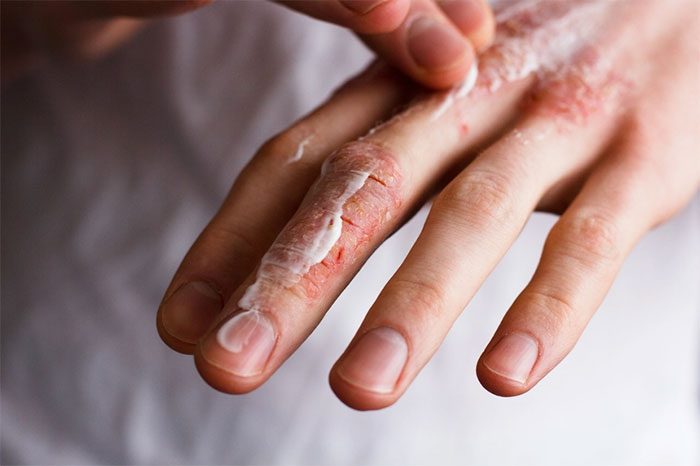
Individuals with eczema or conditions that cause cracked skin are more susceptible to cellulitis. (Image: Internet).
5. How is cellulitis diagnosed?
Diagnosing cellulitis typically involves a physical examination by a physician. They will assess the affected area and inquire about the symptoms. Sometimes, blood samples or wound samples may be taken for testing to confirm the infection and determine the appropriate treatment method, such as:
- Blood tests: Blood tests are an important diagnostic tool that can confirm whether the cellulitis infection has spread to the bloodstream. By analyzing specific markers, healthcare providers can determine the severity of the infection and develop an appropriate treatment plan.
- Skin tests: Skin tests are performed to identify the type of bacteria causing your cellulitis. This information is crucial for prescribing the correct antibiotic treatment. By identifying the specific bacteria, healthcare providers can ensure targeted therapy, minimizing the risk of treatment failure or antibiotic resistance.
- Bacterial cultures: Bacterial cultures involve taking samples from the affected area to identify the specific bacteria causing cellulitis. This method helps healthcare providers select the most appropriate antibiotics to combat the infection. By treating based on the specific bacteria, patients have a higher chance of successful recovery.
6. How is cellulitis treated?
Treatment for cellulitis usually involves the use of antibiotics, typically taken for at least five days. In severe cases, intravenous antibiotics may be necessary. Doctors may also prescribe pain relievers.
Note that following the prescribed antibiotic regimen is crucial to ensure complete eradication of the infection and prevent antibiotic resistance. In addition to antibiotics, home care measures may be applied, such as:
- Warm compress: Use a clean warm compress on the affected skin area.
- Elevating the affected limb above heart level may also help reduce swelling.
- Using compress techniques and taking non-steroidal anti-inflammatory drugs (NSAIDs) can help alleviate symptoms and promote healing.
- Avoid any activities that may exacerbate the affected areas, including walking, running, or other exercises.
If you have an abscess, the doctor may need to drain it. Most people feel better within 7 to 10 days of treatment.
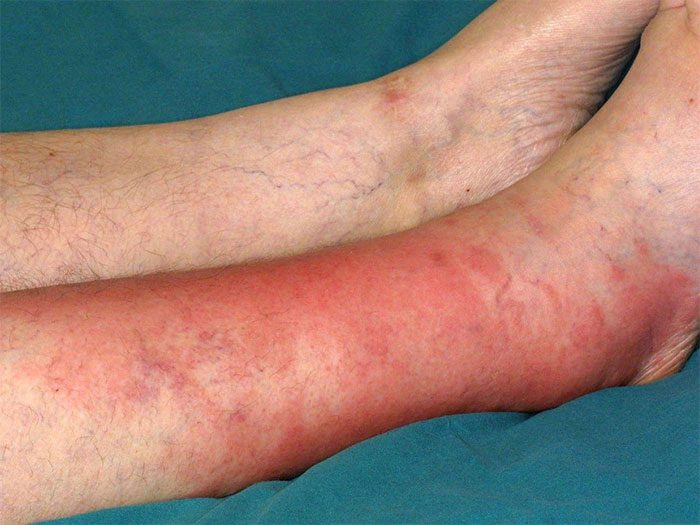
Treatment for cellulitis typically involves the use of antibiotics. (Image: Internet).
7. Can cellulitis be prevented?
You can prevent and reduce the risk of cellulitis through several measures:
- If your skin is cracked, clean it immediately and apply an antibiotic ointment. Cover the wound until it heals and change the bandage daily.
- Monitor the wound for any discoloration, drainage, or pain. These could be signs of infection.
- Keep your skin moisturized to prevent cracking.
- Treat any conditions that cause skin cracking, such as athlete’s foot, promptly.
- Wear protective gear when working or engaging in sports.
- Check your feet daily for signs of injury or infection.
8. Frequently asked questions
8.1. Can cellulitis recur?
While most people recover completely from cellulitis, the infection can recur in the future. Those with skin conditions such as athlete’s foot or diabetes are more susceptible to recurrence. About 33% of individuals with cellulitis will experience a recurrence.
Caring for wounds carefully and implementing preventive strategies can help reduce the risk of recurrence.
8.2. Can cellulitis cause complications?
If left untreated, cellulitis can lead to complications such as tissue damage, septic shock, damage to infected internal organs, limb amputation, and even death.
8.3. Is cellulitis itchy?
No, cellulitis is not itchy. However, the affected area may become itchy as the skin begins to heal.
Above are the details regarding cellulitis. This is a dangerous bacterial infection, so it is crucial for everyone to be particularly vigilant. If you notice any suspicious symptoms, you should visit a hospital immediately for examination and treatment.









































